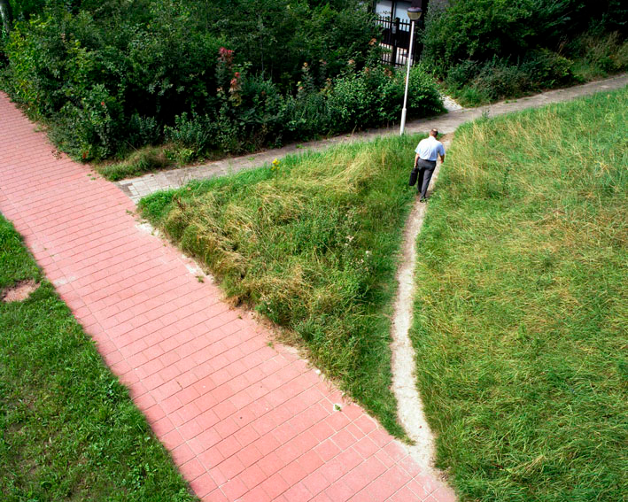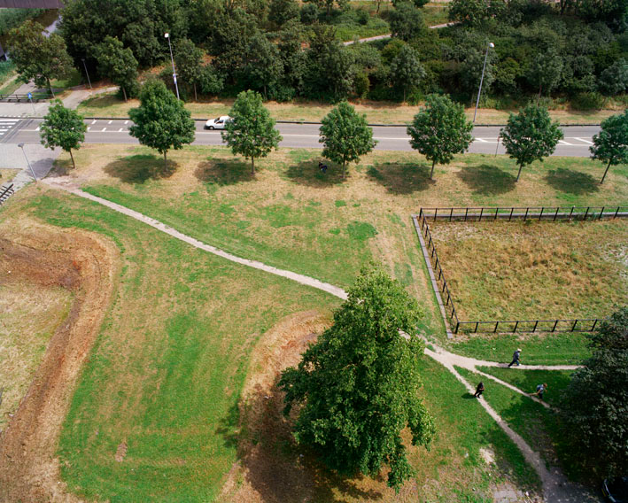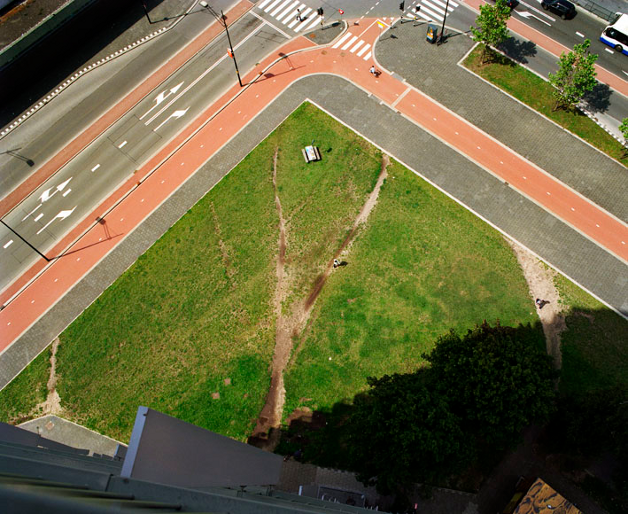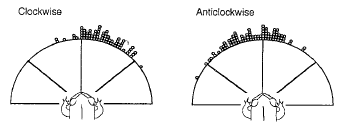We all know shortcuts like this:

Photo: Jan-Dirk van der Burg (olifantenpaadjes.nl)
Trails of this sort go by various names. In a photo album devoted entirely to the subject, the Dutch photographer Jan-Dirk van der Burg has coined (or at least popularized) the term "elephant trail" (olifantenpaadje). Wikipedia adopts the more sensuous "desire path". And, of course, there is the simple "shortcut". But regardless the name, it is an intriguing phenomenon. Because these trails are shortcuts, to be sure, but usually not quite the shortest path.

Photo: Jan-Dirk van der Burg (olifantenpaadjes.nl)
But why? If you're going to leave the sidewalk anyway, why not head straight to wherever you need to go? Why the little curve, the minor inefficiency? Surely not to please the likes of van der Burg, who revel in their shape and form.

Photo: Jan-Dirk van der Burg (olifantenpaadjes.nl)
Surprisingly enough, desire paths can be modeled fairly easily. Helding and colleagues have proposed a model in which they are the result of only two opposing "social forces": The tendency to take the shortest path (i.e., a straight line) and the tendency to take the most comfortable path.
The crux of the model is the assumption that paths become increasingly more comfortable as people use them. Which is true, of course, because usage smoothens a path by killing off vegetation, etc. Another factor is the social comfort of walking where others have walked before: Most people do not want to be a rogue wanderer …



![A milk splash has a surprisingly regular shape (Source: [url=http://www.flickr.com/photos/photo_art/2406246243/]Robbie[/url])](http://www.cogsci.nl/images/stories/blog/misc/milksplash.jpg) By definition, a swarm consists of a group of individuals. In the case of bees, and arguably in the case of humans as well, these individuals are driven by simple impulses. They react to other individuals in their immediate vicinity, but there is no master plan, and very little in the way of group coordination. And yet, somehow, from this teeming, chaotic mess, organized behavior does arise.
By definition, a swarm consists of a group of individuals. In the case of bees, and arguably in the case of humans as well, these individuals are driven by simple impulses. They react to other individuals in their immediate vicinity, but there is no master plan, and very little in the way of group coordination. And yet, somehow, from this teeming, chaotic mess, organized behavior does arise.![Visual acuity drops of rapidly with distance from the fovea (source: [url=http://en.wikipedia.org/wiki/Fovea_centralis]Wikipedia[/url])](http://www.cogsci.nl/images/stories/blog/figures/foveal_acuity.png) As you probably know, we see only a small part of our surroundings with high resolution and in color. This is the part that falls onto our fovea, a small, extra dense part of the retina. Foveal vision corresponds to about the size of a thumb at arm's length.
As you probably know, we see only a small part of our surroundings with high resolution and in color. This is the part that falls onto our fovea, a small, extra dense part of the retina. Foveal vision corresponds to about the size of a thumb at arm's length.
![A schematic brain depicted from above (Source: [url=http://commons.wikimedia.org/wiki/File:Cerebral_lobes.png]Wikimedia commons[/url])](http://www.cogsci.nl/images/stories/blog/hemispheres.png) As you probably know, brains of humans and other vertebrates consist of two halves, called hemispheres. By and large, both hemispheres carry out the same functions, but they are not identical. The best known asymmetry between the two hemispheres is the lateralization of language: The left hemisphere is dominant when it comes to language. Another obvious example is handedness: The right hand is primarily controlled by the left hemisphere, and vice versa, so handedness reflects a hemispheric specialization in the control of hand movements. Again, the left hemisphere is usually dominant.
As you probably know, brains of humans and other vertebrates consist of two halves, called hemispheres. By and large, both hemispheres carry out the same functions, but they are not identical. The best known asymmetry between the two hemispheres is the lateralization of language: The left hemisphere is dominant when it comes to language. Another obvious example is handedness: The right hand is primarily controlled by the left hemisphere, and vice versa, so handedness reflects a hemispheric specialization in the control of hand movements. Again, the left hemisphere is usually dominant.
